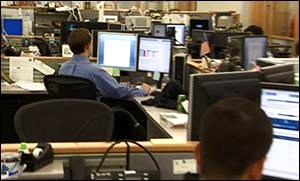Courtesy of Pam Martens.
Photo of the Trading Floor at the New York Fed (Obtained by Wall Street On Parade from an Educational Video Despite Stonewalling by the New York Fed)
Your humble editor and publisher of Wall Street On Parade might have had a little something to do with a growing mutiny in Congress. Back on November 4, 2012 and again on July 25, 2013, we blew the whistle on an obscene, secret entitlement program between the Fed and the too-big-to-fail banks: a century old program where every year, boom or bust, despite the overall level of interest rates in the markets, the Fed pays out a risk-free, guaranteed 6 percent dividend to its member banks. (All Fed member banks get the dividend but the lion’s share goes to the biggest Wall Street banks because their capital dwarfs all other banks.)
Now, after more than a hundred years, there’s a plan in Congress to shrink that payout to 1.5 percent and fix our crumbling roads with the savings. Only banks with $1 billion or more in assets would be affected.
The Federal Reserve mandates that its member banks subscribe to “stock” in an amount equal to 6 percent of their capital and surplus. The banks have to post half that amount with the Fed upon becoming a member; the other half is subject to being called upon. The deposited capital translates into a corresponding share of “stock” in one of the 12 regional Fed banks. (The biggest Wall Street banks, of course, prefer holding their shares in their crony New York Fed.) The “stock” then pays out the 6 percent dividend to shareholders, meaning the banks.
If the bank had a hand in crashing the economy twice in the past century, say in 1929 and again in 2008 – like JPMorgan and Citigroup – it gets an extra bonus: its 6 percent dividend is tax-exempt. That’s because the statutes say that if the bank’s shares in the Fed were acquired prior to March 28, 1942 the bank doesn’t have to pay corporate taxes on it. JPMorgan’s roots reach into the eighteenth century while Citibank, part of Citigroup, traces its founding to the City Bank of New York in 1812. CEOs of both banks were shamed before Congress in the 1930s for their role in the crash of ’29 and again following the 2008 Wall Street crash.
But these two banks achieved even greater ignominy in May of this year: both pleaded guilty to a felony charge, admitting that they participated in a banking cartel to rig foreign currency trading. In other words, the Fed, the regulator of these banks, is paying this lavish 6 percent dividend to admitted felons while U.S. college students are going without food and heat and opting for prostitution to pay their more than $1 trillion in student debt – much of it saddled on their backs by these same banks.
…




